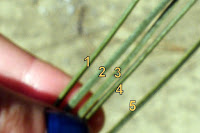Happy February, everyone! We've entered the month of Groundhog Day, the Lunar New Year (which is right now, for those that didn't know), the Superbowl and that dastardly day of Hallmark Holidays, Valentine's Day. Now, as far as traditional garb for Groundhog Day goes, I'm unsure of what one wears for those festivities. Superbowl fans sometimes paint their faces and wear team jerseys and colors. (What do I know about football? Hardly anything, to be honest.)
Nevertheless, I do know for sure that concerning the Lunar New Year and Valentine's Day, the color red plays a very prominent role in both holidays. In Chinese and Vietnamese cultures, the color red represents good luck and good fortune. Western cultures associate red with passion, love, and romance-- and on Valentine's Day, plenty of red and pink can be found. Additionally, in many historic cultures the world over, red garments were reserved for royals and the wealthy upper classes that could afford this lavish color.
 |
The Scarlet Mantle of King Ferdinand I of Austria.
(Those royals really knew how to class up an affair!) |
Why so much emphasis on the color red? What made it so valuable that it became a symbol of wealth, power, and luxury? The answer lies in the tiny bodies of some very interesting insects called cochineal.
 |
| The white fuzz that you see is a protective web-like coating that cochineal produce. |
Cochineal (Dactylopius coccus) are members of the hemiptera order of insects-- the same order as mealy bugs and aphids. Like other members of the hemipteran order, they possess piercing mouthparts designed to suck liquids from the plants that they infest. In the case of cochineal, the plants of choice are specific varieties of prickly-pear cactus that native to Mexico, Chile, Bolivia, the Canary Islands, and Peru. Above, you see a pad from a prickly-pear cactus that we found in the UCSD Ecological Reserve, located just north of the Geisel Library.
_04_ies.jpg) |
| A cluster of female cochineal. Male cochineal, which are winged, do not exhibit the same morphism or even life cycle. |
Female cochineal live fairly sessile lives with their needle-like mouthparts constantly inserted into the fleshy surfaces of cacti, feeding and waiting to be mated with. Male cochineal, on the other hand, have a very different lifecycle from the females. Like many members of the insect class, cochineal develop overtime in stages of growth and molting. In the final phase of development, they develop functioning sexual organs and in the case of the males, wings. The newly developed adult males then fly from female to female, trying to mate with as many as possible before they die, a week after this final molt. Even food does not distract them from this mission, as in their final stage of life, the males no longer have mouthparts. A doomed, yet genetically productive adulthood, indeed!
WARNING: SLIGHTLY GRAPHIC BUG SQUISHING!
(But it gets the point across.)
 |
| Really, we would have avoided this if we could. But all in the name of science... |
In ancient times, the indigenous tribes of these regions would cultivate the insects on the cacti and collect, dry, and harvest them for carminic acid, a deep red internal secretion that makes up almost a quarter of a dried cochineal's body weight.
 |
| "Indian Collecting Cochineal with a Deer Tail" from Memoria sobre la naturaleza, cultivo, y beneficio de la grana |
Once the Europeans set foot in the Americas and saw that the natives had an efficient way of procuring red pigments for clothing and other accessories-- most importantly, one that did not fade over time-- the Europeans (especially the Spaniards) tried to bring pricky-pear back to Europe for cochineal cultivation. In the temperate climates of Europe, however, it was difficult to grow pricky-pear and a the development of a successful business in carmine dye eluded the Europeans for three centuries. Reliant on trade from the New World, carmine dye became a valuable commodity and thus, only the wealthy and royal could afford to have their clothes dyed this deep, rare color.
Ok. So, historically, rich people, kings, and indigenous folks got their scarlet garb by squishing bugs and using their insides. Gross and awesome. But why is this relevant now in an age of synthetic dyes? Well believe it or not, we still use cochineal-derived dyes today! Next time you buy clothes, make-up, and even some food items, look for these names in the ingredients:
- Cochineal
- Crimson Lake
- Natural Red #40
- C.I. 75470
- E120
So, next time you're walking past Geisel Library towards Hopkins Parking and you spot some pricky-pear on the side of the road with suspicious white fuzz growing on the surface... proceed with caution and mindfulness. :)
What? You expect me to endorse the needless squishing of really awesome bugs? No way!
Happy Groundhog Day, Happy New Year, Happy Superbowl, and Happy Valentine's Day!




















_04_ies.jpg)

